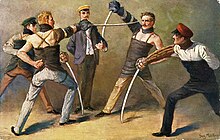Student fencing weapon
A student fencing weapon is a fencing weapon that is used in striking connections for fencing of lengths .
Stabbing weapons of the early modern times
After the end of the Middle Ages, the same fencing weapons were used by students as they were otherwise used by men authorized to carry weapons for self-defense, such as swords and rapiers .
From the middle of the 18th century until well into the 19th century, the Parisian thrusting sword was in use for butt marks , a light floret-like thrusting weapon with a circular guard and a blade with a triangular cross-section.
Transition to cutting weapons in the 18th century

Since such stabbing weapons could more easily lead to fatal injuries, from 1767 the first thing to do in Göttingen was to use cut weapons . This development was triggered by a duel that took place on April 22nd, 1766 on the first floor of the side wing of the Göttingen Michaelishaus and ended fatally with a stab in the heart. It was the only event of its kind in Göttingen in the entire 18th century. As a result, strict investigations took place by the university authorities, which had to report to the government in Hanover . The consequences of a duel with a fatal outcome also became clear among the students: According to Article 14 of the Duel Edict of July 18, 1735, the death penalty awaited the other participant in such a case:
"If a duel happens and one of the duelists is killed, the perpetrator, regardless of his status or nature and without any pardon, should be brought from life to death with the sword and his corpse should no less bury the corpse of the abductee in an abortion become. If one cannot get hold of the person of the murderer, his portrait is to be hung on the gallows with a description of the nature of his crime. However, this punishment in effigy should not cancel the death penalty ... "
With the development of the Göttingen bat as a pure cutting weapon, the risk of final stab wounds was eliminated. The next fatal duel did not take place in Göttingen until 1808.
Furthermore, from the Göttingen Hieber the basket racket and - at the universities in the east (roughly: east of the Elbe) of Germany - the bell racket were developed.
Since fencing with basket beater and bell beater no longer had the character of a duel around the middle of the 19th century, the academic saber was created to clear up difficult honors , which differed from the basket beater only in its heavier and curved blade. In addition, the position of the Paukanten was more flexible, i.e. more dangerous, and fewer protective weapons were used. Saber games were considered a duel with deadly weapons and thus duels . They were carried out until about 1935.
Today's use of weapons

The censorship has been carried out since around 1850 to this day with a basketball club and bell hammer.
The German student associations in Prague still used a special weapon in the middle of the 19th century, the Prague Plempe , until they also switched to the basket racket in the 1870s.
Efforts in the interwar period to defuse student fencing by changing equipment ( reform bat ) and rules (mobile fencing) at the same time and to make it more demanding, came to an end when the connections were dissolved in the 1930s.
After the Second World War, scale fencing continued in principle, as it had existed until 1935. The fighting of duels with the saber was not resumed, however, and the bell-striker was only used sporadically, as in the other university towns where it was common, the Soviet occupation prevented the resumption of old traditions. After German reunification, however, this weapon was used again in the traditional university towns of Halle, Leipzig, Dresden, Freiberg, Greifswald and Berlin, and since 1984 also in Constance. In the former Königsberg , in Gdansk and in Wroclaw , where the bell-ringer fights were used in the past, there are no longer courses today. In Warsaw today there is a racket fight.
Timetable
literature
- Rudolf Beglinger: The weapons of the students from the 15th to the 18th century. In: then and now. 2005 yearbook of the Society for Corps Student History Research. Vol. 50, 2005, ISSN 0420-8870 , pp. 61-70.
- Martin Biastoch: Duel and scale in the empire. Using the example of the Tübingen Corps Franconia, Rhenania, Suevia and Borussia between 1871 and 1895 (= GDS archive for university and student history. Supplement 4). SH-Verlag, Schernfeld 1995, ISBN 3-89498-020-6 .
- Adolf Meyer: New school of commentary academic racket fencing. Roßberg, Leipzig 1906 (reprint. WJK-Verlag, Hilden 2006, ISBN 3-933892-13-9 ).
- Hermann Rink : From student fencing to the scale. In: Handbook of the Kösener Corps student. 6th edition. Volume 1. Association of Alter Corpsstudenten eV, Würzburg 1985, pp. 151-171.
- Hermann Rink: The scale length, an essential feature of the association. In: Rolf-Joachim Baum (Ed.): "We want men, we want action!" German corps students from 1848 to today. Siedler, Berlin 1998, ISBN 3-88680-653-7 , pp. 383-402.
- Friedrich Schulze: The art of saber fencing. A thorough guide to right and left fencing. At the same time a text and learning book for use at universities and military educational institutions, as well as for gymnastics and fencing clubs. Petters, Heidelberg 1889 (reprint. WJK-Verlag, Hilden 2005, ISBN 3-933892-89-9 ).
- Friedrich Schulze: The art of fencing with the Hau rapier. With special consideration of the left fencing with exercise examples and five tables in collotype. Bangel & Schmitt, Heidelberg 1885 (reprint. WJK-Verlag, Hilden 2006, ISBN 3-933892-14-7 ).
Individual evidence
- ↑ Quoted from Otto Deneke: A Göttingen student duel from 1766. Göttingen undated (1934)




